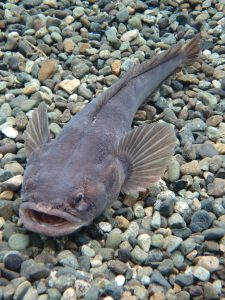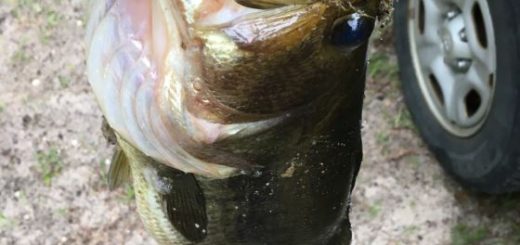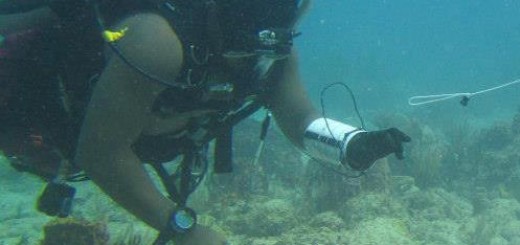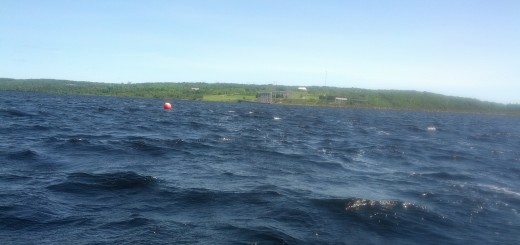The plainfin midshipman: habitat extremophile

Many of the rocks in this intertidal zone are nests for male plainfin midshipman. During low tide, these males must contend with extreme environmental conditions and predators unique to this habitat, like the great blue heron pictured here. Photo credit: Jessica Miller.
The plainfin midshipman, Porichthys notatus, is a deep sea marine fish. However, researchers don’t need advanced submersibles or complex fishing gear to study this species All they need is a pair of sturdy rubber boots and a willingness to search the rocky intertidal zones from late spring until early fall. During its summer breeding season, the wonderfully weird plainfin midshipman transcends habitats, migrating from the stable environment of the deep sea to the fluctuating and dynamic intertidal zone. The intertidal zone is a habitat of extremes. Intertidal organisms regularly experience dramatic changes in temperature, oxygen, and other environmental parameters that are paramount to their survival every time the tide comes in and goes out. Midshipman males excavate nests under large rocks all long the intertidal zone, staying in these nests to take care of their offspring, and therefore subjecting themselves to the daily fluctuations in environmental conditions. In this species, males provide parental care.1 A day in the life of a midshipman dad might consist of happily swimming in well-oxygenated, cool water one moment, then laying on rocks completely exposed to the air and mid-day summer temperatures an hour later. However, midshipman have evolved the ability to survive these stressful conditions for up to 8 hours.2

ABEL researchers lift open a rock nest to reveal on its surface a clutch of plainfin midshipman eggs, which the guarding male underneath protects, as well as the eggs of marine invertebrates and other marine animals. Photo credit: Karen Cogliati
Why do midshipman fish breed in such extreme conditions? One theory is that the extreme conditions of the intertidal zone are relatively – and counterintuitively – safe locations for raising offspring, something midshipman males do with gusto. Males will maintain their rock nests for many months, aerating their eggs and defending them from other males and predators who may eat them.3 A successful male may receive multiple clutches of eggs from multiple females, and each clutch will develop for approximately 2 months before hatching.2 All this while, he does not feed and becomes emaciated by the end of the breeding season.4
How do midshipman males survive both the stresses of parental care and their extreme environment? In response to low dissolved oxygen levels in the water (i.e. aquatic hypoxia), nesting midshipman males are able to drop their metabolic rate and elevate lactate in their heart and liver glucose to overcome physiological stress due to hypoxia.5 Beyond simply surviving hypoxic conditions, midshipman males use this otherwise stressful habitat to their advantage when it comes to mating. In hypoxic conditions, their sperm actually swim faster, theoretically increasing fertilization success.6

A midshipman male rests on the bottom of a tank at a research facility at the University of Victoria, British Columbia. Photo credit: Jessica Miller.
The Aquatic Behavioural Ecology Lab at McMaster University has been researching extreme habitat adaptation in the plainfin midshipman for over 10 years. With such a multi-faceted, convenient model species, it’s relatively easy to ask interesting questions such as, “why would a fish choose to raise its vulnerable young in a habitat that dries up twice a day?” and “what kind of physiological changes occur between living in the deep ocean and the intertidal zone?” There is still so much to learn from the plainfin midshipman, a fish that leads a double life.
References:
- Hubbs, C. L. 1920. The bionomics of Porichthy notatus Girard. Am Nat 54: 380–384.
- Arora, H. L. 1948. Observations of the habits and early life history of the Batrachoid fish, Porichthys notatus Girard. Copeia 2: 89-93.
- DeMartini, E. E. 1991. Spawning success of the male plainfin midshipman. II. Substratum as a limiting spatial resource. J Exp Mar Biol Ecol 146: 235–251.
- Bose, A. P. H., McClelland, G. B., Balshine, S. 2015. Cannabalism, competition, and costly care in the plainfin midshipman fish, Porichthys notatus. Behav. Ecol. 27 (2): 628-636.
- Craig, P. M., Fitzpatrick, J. L., Walsh, P. J., Wood, C. M., McClelland, G. B. 2013. Coping with aquatic hypoxia: how the plainfin midshipman (Porichthys notatus) tolerates the intertidal zone. Environ. Biol. Fish. 97: 163.
- Fitzpatrick, J. L., Craig, P. M., Bucking, C., Balshine, S., Wood, C. M., McClelland, G. B. 2009. Sperm performance under hypoxic conditions in the intertidal fish Porichthys notatus. Can. J. Zool. 87: 464-649.

Jessica Miller from the Aquatic Behavioural Ecology Lab at McMaster University in Hamilton, ON, CA.

The Aquatic Behavioural Ecology Lab at McMaster University.
About the Author:
Jessica Miller is a master’s student in the Psychology, Neuroscience, & Behaviour Dept at McMaster University. She is supervised by Dr. Sigal Balshine, who runs the Aquatic Behavioural Ecology Lab (ABEL). Her thesis focuses on reproductive physiology and post-copulatory competition in the plainfin midshipman fish, specifically investigating the form and function of the reproductive accessory gland and its role in sperm competition. Jessica received her BSc in Marine Biology at Dalhousie University, where she completed a thesis studying the effects of stress on immunity and behaviour in crickets.



